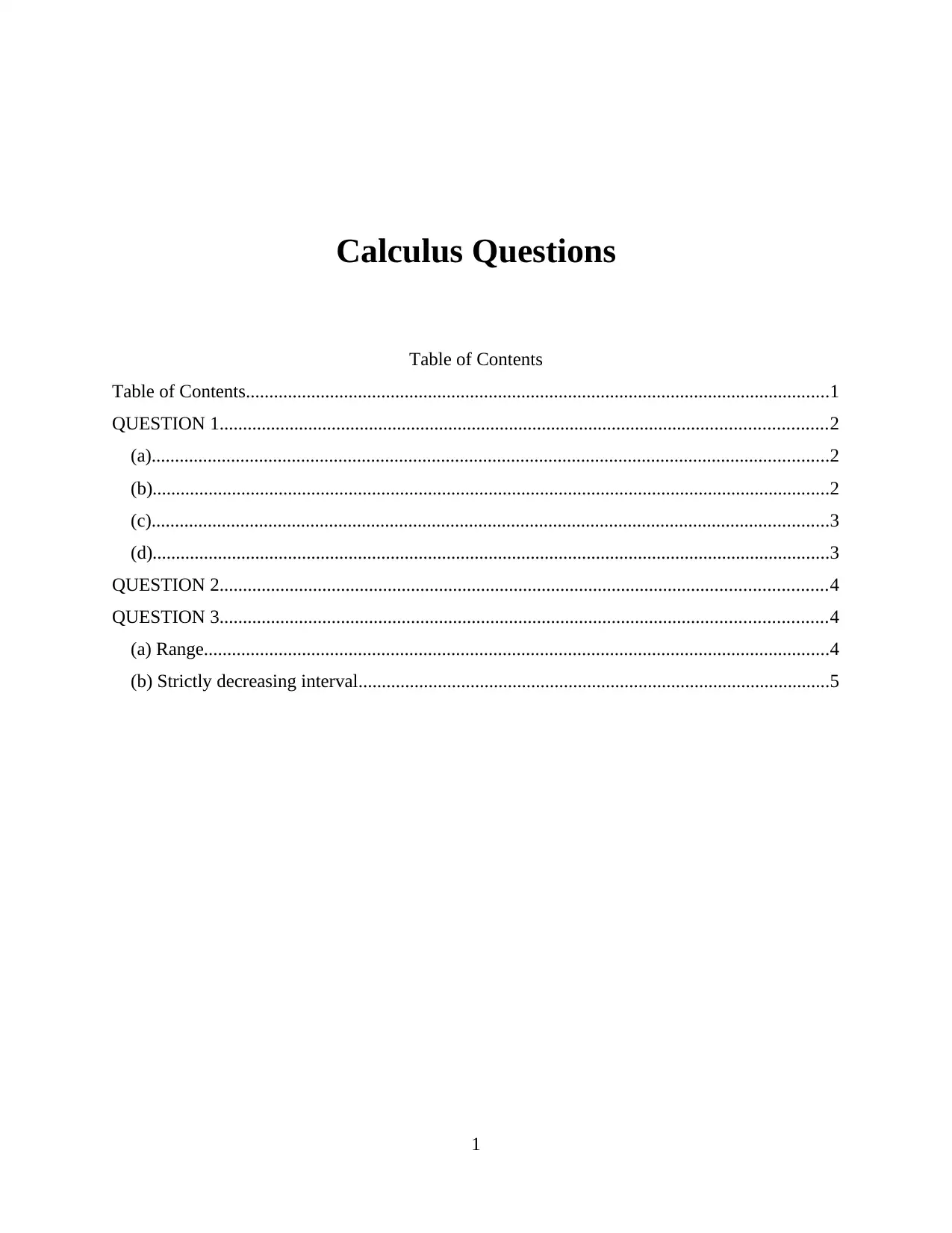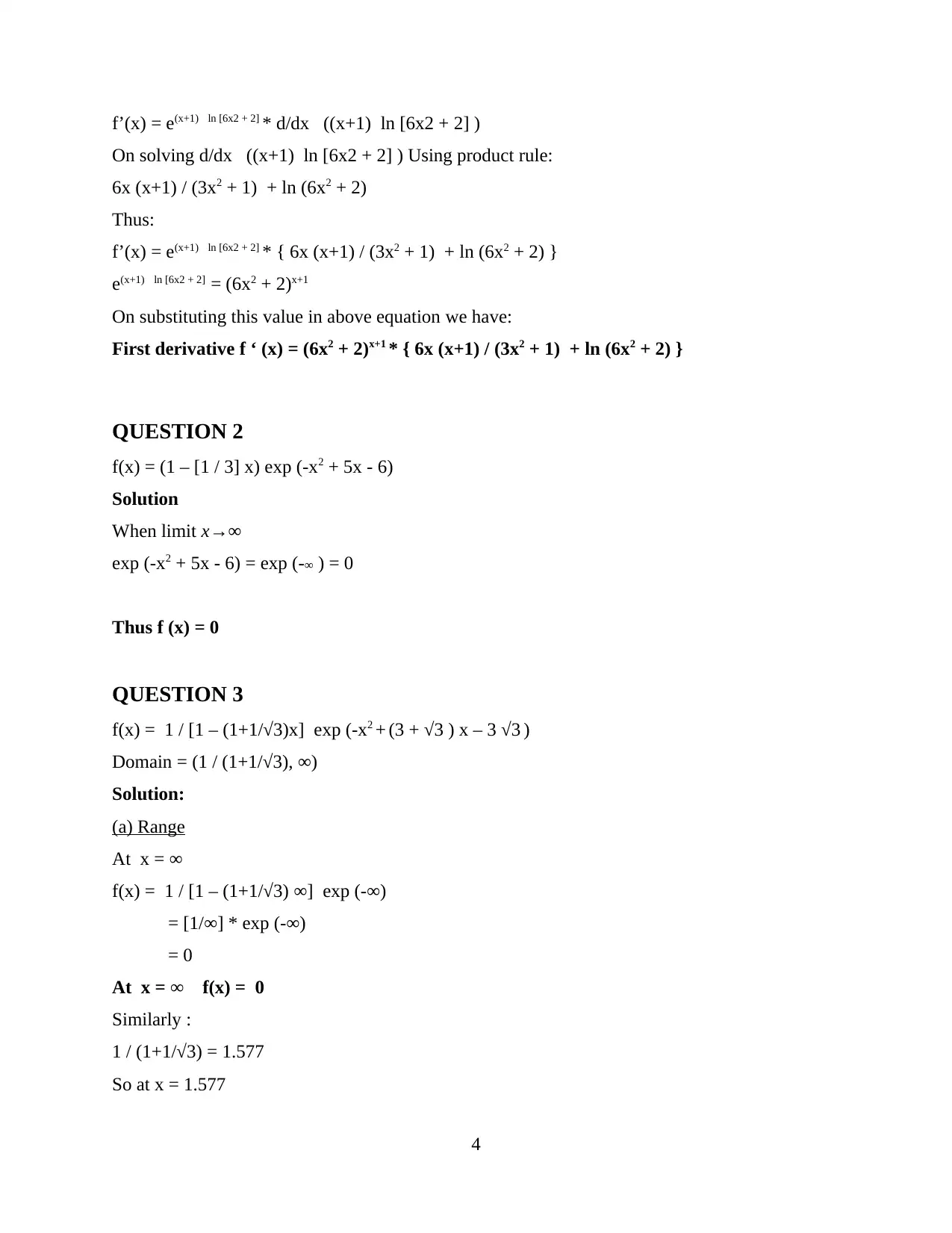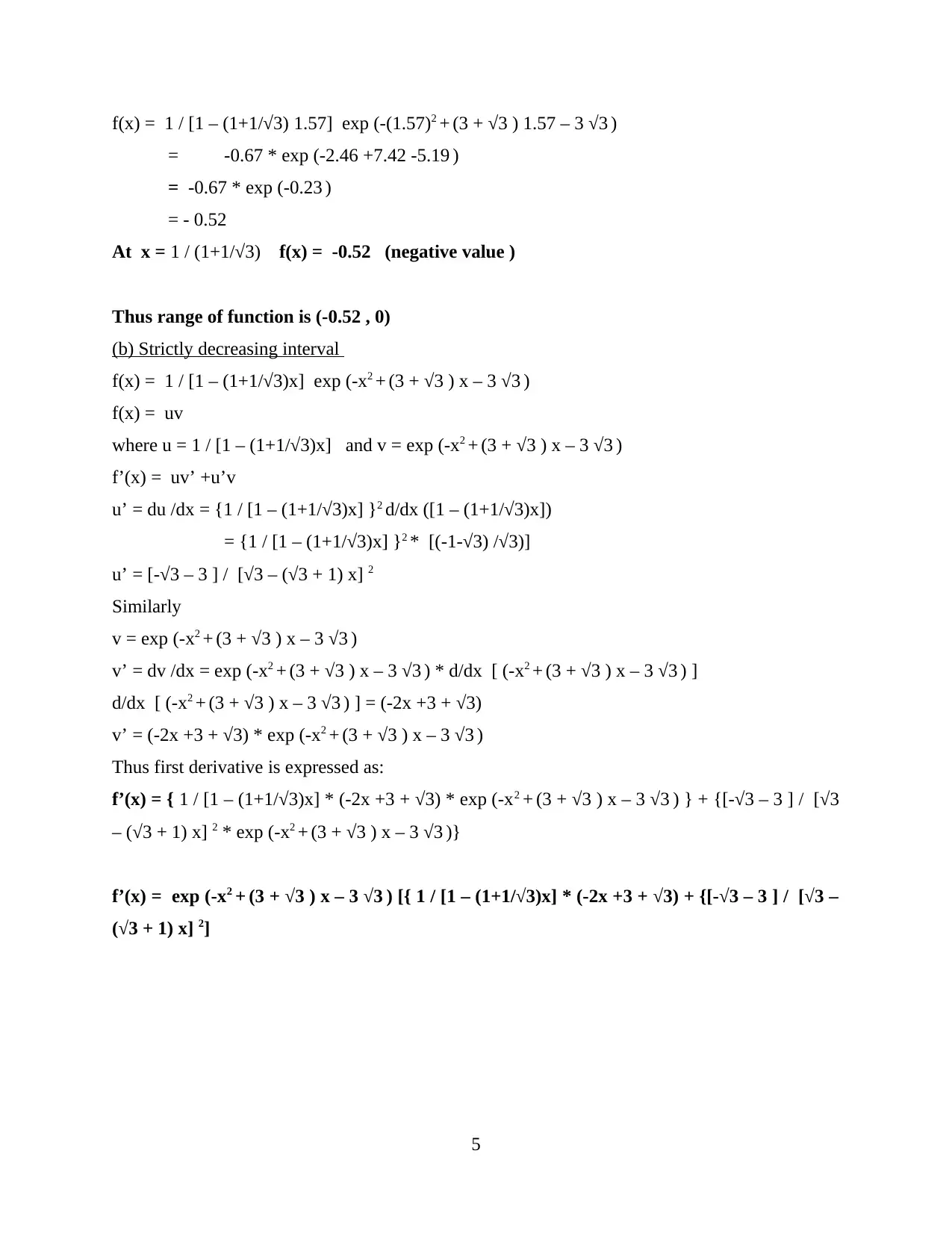Calculus Problem Set: Derivatives, Limits, and Function Analysis
VerifiedAdded on 2023/06/17
|5
|1672
|442
Homework Assignment
AI Summary
This calculus assignment provides detailed solutions for various problems, including finding first and second derivatives of complex functions involving exponential terms and quotients. It covers applications of chain rule and product rule in differentiation. The solutions also include evaluating limits and determining the range and strictly decreasing intervals of a given function. The document includes step-by-step explanations for each problem, making it a valuable resource for students studying calculus. Access more solved assignments and past papers on Desklib.

Calculus Questions
Table of Contents
Table of Contents.............................................................................................................................1
QUESTION 1..................................................................................................................................2
(a).................................................................................................................................................2
(b).................................................................................................................................................2
(c).................................................................................................................................................3
(d).................................................................................................................................................3
QUESTION 2..................................................................................................................................4
QUESTION 3..................................................................................................................................4
(a) Range......................................................................................................................................4
(b) Strictly decreasing interval.....................................................................................................5
1
Table of Contents
Table of Contents.............................................................................................................................1
QUESTION 1..................................................................................................................................2
(a).................................................................................................................................................2
(b).................................................................................................................................................2
(c).................................................................................................................................................3
(d).................................................................................................................................................3
QUESTION 2..................................................................................................................................4
QUESTION 3..................................................................................................................................4
(a) Range......................................................................................................................................4
(b) Strictly decreasing interval.....................................................................................................5
1
Paraphrase This Document
Need a fresh take? Get an instant paraphrase of this document with our AI Paraphraser

QUESTION 1
(a)
f(x) = (x9.5 – 3 + 1) (5 – [1 / (x2+1)])
Solution
f(x) = (x9.5 – 3 + 1) (5 – [1 / (x2+1)])
= 5 x6.5 - x6.5 / x3 + 5 – 1/x3
= 5 x6.5 – x3.5 + 5 – 1/x3
First derivative = f’(x)
f’(x) = 32.5 x5.5 – 3.5 x2.5 + 3x-4
Second derivative = f ’’(x) = 178.75 x4.5 – 8.75 x1.5 - 12 x-5
(b)
f(x) = exp √[x2 – (2/x) ]
Solution
f(x) = exp √[x2 – (2/x) ]
Let √[x2 – (2/x) ] = w
d/dx (ew) = dw/dx*ew
f’(x) = d/dx (√[x2 – (2/x) ]) * exp √[x2 – (2/x) ]
Again d/dx (√x) = 0.5 (x)-0.5
Applying this chain rule:
d/dx (√[x2 – (2/x) ]) = (2x + 2x-2)0.5 * [x2 – (2/x) ]-0.5
Thus f’(x) =(2x + 2x-2)0.5 * [x2 – (2/x) ]-0.5 * exp √[x2 – (2/x) ]
First derivative = 0.5*[x2 – (2/x) ]-0.5)* exp √[x2 – (2/x) ] * [2x + 2x-2]
Second derivative =
f’’(x) = d/dx [(0.5) (x2 –2x-1)-0.5 exp √[x2 – (2/x) ] * [2x + 2x-2]]
Let u = [(0.5) (x2 –2x-1)-0.5 * [2x + 2x-2] ]
On simplifying we have u = 2x3 + 1 -2 – 2x-3
du/dx = 3x2 + 6x-4
Let v = exp √[x2 – (2/x) ]
dv/dx = 1 / {2 *√ [x2 – (2/x) ] } * (2x + 2x-2) exp √[x2 – (2/x) ]
so f ’’(x) = u dv/dx + v* du/dx
2
(a)
f(x) = (x9.5 – 3 + 1) (5 – [1 / (x2+1)])
Solution
f(x) = (x9.5 – 3 + 1) (5 – [1 / (x2+1)])
= 5 x6.5 - x6.5 / x3 + 5 – 1/x3
= 5 x6.5 – x3.5 + 5 – 1/x3
First derivative = f’(x)
f’(x) = 32.5 x5.5 – 3.5 x2.5 + 3x-4
Second derivative = f ’’(x) = 178.75 x4.5 – 8.75 x1.5 - 12 x-5
(b)
f(x) = exp √[x2 – (2/x) ]
Solution
f(x) = exp √[x2 – (2/x) ]
Let √[x2 – (2/x) ] = w
d/dx (ew) = dw/dx*ew
f’(x) = d/dx (√[x2 – (2/x) ]) * exp √[x2 – (2/x) ]
Again d/dx (√x) = 0.5 (x)-0.5
Applying this chain rule:
d/dx (√[x2 – (2/x) ]) = (2x + 2x-2)0.5 * [x2 – (2/x) ]-0.5
Thus f’(x) =(2x + 2x-2)0.5 * [x2 – (2/x) ]-0.5 * exp √[x2 – (2/x) ]
First derivative = 0.5*[x2 – (2/x) ]-0.5)* exp √[x2 – (2/x) ] * [2x + 2x-2]
Second derivative =
f’’(x) = d/dx [(0.5) (x2 –2x-1)-0.5 exp √[x2 – (2/x) ] * [2x + 2x-2]]
Let u = [(0.5) (x2 –2x-1)-0.5 * [2x + 2x-2] ]
On simplifying we have u = 2x3 + 1 -2 – 2x-3
du/dx = 3x2 + 6x-4
Let v = exp √[x2 – (2/x) ]
dv/dx = 1 / {2 *√ [x2 – (2/x) ] } * (2x + 2x-2) exp √[x2 – (2/x) ]
so f ’’(x) = u dv/dx + v* du/dx
2

On substituting values, we have:
Second derivative:
f ’’(x) = [(0.5) (x2 –2x-1)* [2x + 2x-2] ] 1 / {2 *√ [x2 – (2/x) ] } * (2x + 2x-2) exp √[x2 – (2/x) ]
+ exp √[x2 – (2/x) ] [3x2 + 6x-4 ]
(c)
f(x) = [1/ 5x +4] exp (3 – 3x2)
Solution
First derivative:
Let [1/ 5x +4] = u and exp (3 – 3x2) = v
d (uv) = uv’ + u’v where u’ and v’ are first derivative of function u and v
u = [1/ 5x +4]
u’ = du/dx = -5 / [5x +4]2
v = exp (3 – 3x2)
v’ = dv/dx = -6x * exp (3 – 3x2)
f’(x) = uv’ + u’v
On substituting values:
f’(x) = [1/ 5x +4] [-6x * exp (3 – 3x2)] + {-5 / [5x +4]2 * exp (3 – 3x2)}
f’(x) = = { exp (3 – 3x2) / [5x + 4] } * {(-6x- 5) / [5x + 4] }
(d)
f(x) = [6x2 + 2] (x+1)
Solution
Using the derivative formula:
If a and b are function of x and in the form (ab ) then they can be simplified as: (ab ) = eb ln a
From observation it can be seen that a = [6x2 + 2] and b = (x+1) so
f(x) = [6x2 + 2] (x+1) = e(x+1) ln [6x2 + 2]
Now differentiating f(x)
dy /dx (e(x+1) ln [6x2 + 2])
On applying chain rule:
3
Second derivative:
f ’’(x) = [(0.5) (x2 –2x-1)* [2x + 2x-2] ] 1 / {2 *√ [x2 – (2/x) ] } * (2x + 2x-2) exp √[x2 – (2/x) ]
+ exp √[x2 – (2/x) ] [3x2 + 6x-4 ]
(c)
f(x) = [1/ 5x +4] exp (3 – 3x2)
Solution
First derivative:
Let [1/ 5x +4] = u and exp (3 – 3x2) = v
d (uv) = uv’ + u’v where u’ and v’ are first derivative of function u and v
u = [1/ 5x +4]
u’ = du/dx = -5 / [5x +4]2
v = exp (3 – 3x2)
v’ = dv/dx = -6x * exp (3 – 3x2)
f’(x) = uv’ + u’v
On substituting values:
f’(x) = [1/ 5x +4] [-6x * exp (3 – 3x2)] + {-5 / [5x +4]2 * exp (3 – 3x2)}
f’(x) = = { exp (3 – 3x2) / [5x + 4] } * {(-6x- 5) / [5x + 4] }
(d)
f(x) = [6x2 + 2] (x+1)
Solution
Using the derivative formula:
If a and b are function of x and in the form (ab ) then they can be simplified as: (ab ) = eb ln a
From observation it can be seen that a = [6x2 + 2] and b = (x+1) so
f(x) = [6x2 + 2] (x+1) = e(x+1) ln [6x2 + 2]
Now differentiating f(x)
dy /dx (e(x+1) ln [6x2 + 2])
On applying chain rule:
3
⊘ This is a preview!⊘
Do you want full access?
Subscribe today to unlock all pages.

Trusted by 1+ million students worldwide

f’(x) = e(x+1) ln [6x2 + 2] * d/dx ((x+1) ln [6x2 + 2] )
On solving d/dx ((x+1) ln [6x2 + 2] ) Using product rule:
6x (x+1) / (3x2 + 1) + ln (6x2 + 2)
Thus:
f’(x) = e(x+1) ln [6x2 + 2] * { 6x (x+1) / (3x2 + 1) + ln (6x2 + 2) }
e(x+1) ln [6x2 + 2] = (6x2 + 2)x+1
On substituting this value in above equation we have:
First derivative f ‘ (x) = (6x2 + 2)x+1 * { 6x (x+1) / (3x2 + 1) + ln (6x2 + 2) }
QUESTION 2
f(x) = (1 – [1 / 3] x) exp (-x2 + 5x - 6)
Solution
When limit x→∞
exp (-x2 + 5x - 6) = exp (-∞ ) = 0
Thus f (x) = 0
QUESTION 3
f(x) = 1 / [1 – (1+1/√3)x] exp (-x2 + (3 + √3 ) x – 3 √3 )
Domain = (1 / (1+1/√3), ∞)
Solution:
(a) Range
At x = ∞
f(x) = 1 / [1 – (1+1/√3) ∞] exp (-∞)
= [1/∞] * exp (-∞)
= 0
At x = ∞ f(x) = 0
Similarly :
1 / (1+1/√3) = 1.577
So at x = 1.577
4
On solving d/dx ((x+1) ln [6x2 + 2] ) Using product rule:
6x (x+1) / (3x2 + 1) + ln (6x2 + 2)
Thus:
f’(x) = e(x+1) ln [6x2 + 2] * { 6x (x+1) / (3x2 + 1) + ln (6x2 + 2) }
e(x+1) ln [6x2 + 2] = (6x2 + 2)x+1
On substituting this value in above equation we have:
First derivative f ‘ (x) = (6x2 + 2)x+1 * { 6x (x+1) / (3x2 + 1) + ln (6x2 + 2) }
QUESTION 2
f(x) = (1 – [1 / 3] x) exp (-x2 + 5x - 6)
Solution
When limit x→∞
exp (-x2 + 5x - 6) = exp (-∞ ) = 0
Thus f (x) = 0
QUESTION 3
f(x) = 1 / [1 – (1+1/√3)x] exp (-x2 + (3 + √3 ) x – 3 √3 )
Domain = (1 / (1+1/√3), ∞)
Solution:
(a) Range
At x = ∞
f(x) = 1 / [1 – (1+1/√3) ∞] exp (-∞)
= [1/∞] * exp (-∞)
= 0
At x = ∞ f(x) = 0
Similarly :
1 / (1+1/√3) = 1.577
So at x = 1.577
4
Paraphrase This Document
Need a fresh take? Get an instant paraphrase of this document with our AI Paraphraser

f(x) = 1 / [1 – (1+1/√3) 1.57] exp (-(1.57)2 + (3 + √3 ) 1.57 – 3 √3 )
= -0.67 * exp (-2.46 +7.42 -5.19 )
= -0.67 * exp (-0.23 )
= - 0.52
At x = 1 / (1+1/√3) f(x) = -0.52 (negative value )
Thus range of function is (-0.52 , 0)
(b) Strictly decreasing interval
f(x) = 1 / [1 – (1+1/√3)x] exp (-x2 + (3 + √3 ) x – 3 √3 )
f(x) = uv
where u = 1 / [1 – (1+1/√3)x] and v = exp (-x2 + (3 + √3 ) x – 3 √3 )
f’(x) = uv’ +u’v
u’ = du /dx = {1 / [1 – (1+1/√3)x] }2 d/dx ([1 – (1+1/√3)x])
= {1 / [1 – (1+1/√3)x] }2 * [(-1-√3) /√3)]
u’ = [-√3 – 3 ] / [√3 – (√3 + 1) x] 2
Similarly
v = exp (-x2 + (3 + √3 ) x – 3 √3 )
v’ = dv /dx = exp (-x2 + (3 + √3 ) x – 3 √3 ) * d/dx [ (-x2 + (3 + √3 ) x – 3 √3 ) ]
d/dx [ (-x2 + (3 + √3 ) x – 3 √3 ) ] = (-2x +3 + √3)
v’ = (-2x +3 + √3) * exp (-x2 + (3 + √3 ) x – 3 √3 )
Thus first derivative is expressed as:
f’(x) = { 1 / [1 – (1+1/√3)x] * (-2x +3 + √3) * exp (-x2 + (3 + √3 ) x – 3 √3 ) } + {[-√3 – 3 ] / [√3
– (√3 + 1) x] 2 * exp (-x2 + (3 + √3 ) x – 3 √3 )}
f’(x) = exp (-x2 + (3 + √3 ) x – 3 √3 ) [{ 1 / [1 – (1+1/√3)x] * (-2x +3 + √3) + {[-√3 – 3 ] / [√3 –
(√3 + 1) x] 2]
5
= -0.67 * exp (-2.46 +7.42 -5.19 )
= -0.67 * exp (-0.23 )
= - 0.52
At x = 1 / (1+1/√3) f(x) = -0.52 (negative value )
Thus range of function is (-0.52 , 0)
(b) Strictly decreasing interval
f(x) = 1 / [1 – (1+1/√3)x] exp (-x2 + (3 + √3 ) x – 3 √3 )
f(x) = uv
where u = 1 / [1 – (1+1/√3)x] and v = exp (-x2 + (3 + √3 ) x – 3 √3 )
f’(x) = uv’ +u’v
u’ = du /dx = {1 / [1 – (1+1/√3)x] }2 d/dx ([1 – (1+1/√3)x])
= {1 / [1 – (1+1/√3)x] }2 * [(-1-√3) /√3)]
u’ = [-√3 – 3 ] / [√3 – (√3 + 1) x] 2
Similarly
v = exp (-x2 + (3 + √3 ) x – 3 √3 )
v’ = dv /dx = exp (-x2 + (3 + √3 ) x – 3 √3 ) * d/dx [ (-x2 + (3 + √3 ) x – 3 √3 ) ]
d/dx [ (-x2 + (3 + √3 ) x – 3 √3 ) ] = (-2x +3 + √3)
v’ = (-2x +3 + √3) * exp (-x2 + (3 + √3 ) x – 3 √3 )
Thus first derivative is expressed as:
f’(x) = { 1 / [1 – (1+1/√3)x] * (-2x +3 + √3) * exp (-x2 + (3 + √3 ) x – 3 √3 ) } + {[-√3 – 3 ] / [√3
– (√3 + 1) x] 2 * exp (-x2 + (3 + √3 ) x – 3 √3 )}
f’(x) = exp (-x2 + (3 + √3 ) x – 3 √3 ) [{ 1 / [1 – (1+1/√3)x] * (-2x +3 + √3) + {[-√3 – 3 ] / [√3 –
(√3 + 1) x] 2]
5
1 out of 5
Related Documents
Your All-in-One AI-Powered Toolkit for Academic Success.
+13062052269
info@desklib.com
Available 24*7 on WhatsApp / Email
![[object Object]](/_next/static/media/star-bottom.7253800d.svg)
Unlock your academic potential
© 2024 | Zucol Services PVT LTD | All rights reserved.





